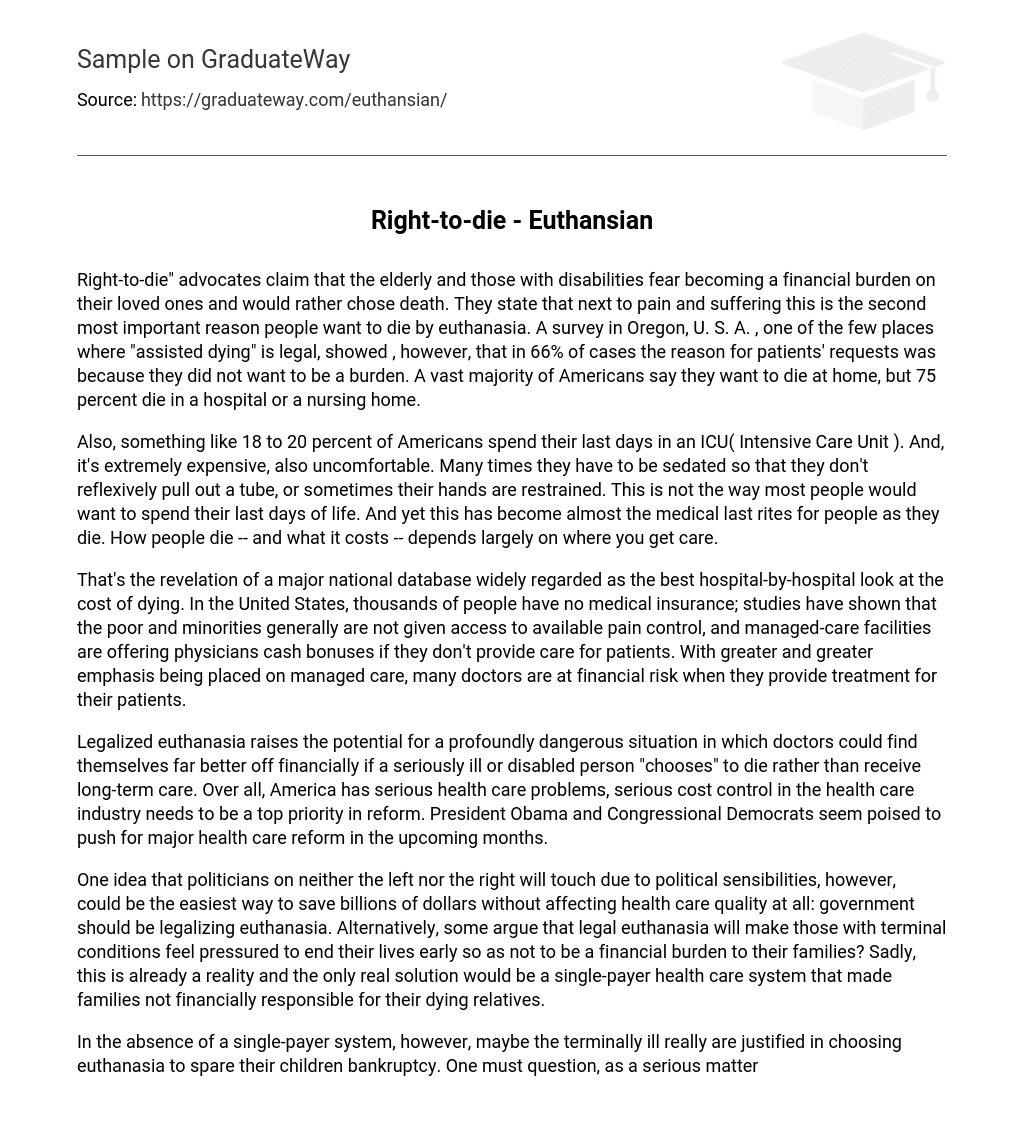Right-to-die” advocates claim that the elderly and those with disabilities fear becoming a financial burden on their loved ones and would rather chose death. They state that next to pain and suffering this is the second most important reason people want to die by euthanasia. A survey in Oregon, U. S. A. , one of the few places where “assisted dying” is legal, showed , however, that in 66% of cases the reason for patients’ requests was because they did not want to be a burden. A vast majority of Americans say they want to die at home, but 75 percent die in a hospital or a nursing home.
Also, something like 18 to 20 percent of Americans spend their last days in an ICU( Intensive Care Unit ). And, it’s extremely expensive, also uncomfortable. Many times they have to be sedated so that they don’t reflexively pull out a tube, or sometimes their hands are restrained. This is not the way most people would want to spend their last days of life. And yet this has become almost the medical last rites for people as they die. How people die — and what it costs — depends largely on where you get care.
That’s the revelation of a major national database widely regarded as the best hospital-by-hospital look at the cost of dying. In the United States, thousands of people have no medical insurance; studies have shown that the poor and minorities generally are not given access to available pain control, and managed-care facilities are offering physicians cash bonuses if they don’t provide care for patients. With greater and greater emphasis being placed on managed care, many doctors are at financial risk when they provide treatment for their patients.
Legalized euthanasia raises the potential for a profoundly dangerous situation in which doctors could find themselves far better off financially if a seriously ill or disabled person “chooses” to die rather than receive long-term care. Over all, America has serious health care problems, serious cost control in the health care industry needs to be a top priority in reform. President Obama and Congressional Democrats seem poised to push for major health care reform in the upcoming months.
One idea that politicians on neither the left nor the right will touch due to political sensibilities, however, could be the easiest way to save billions of dollars without affecting health care quality at all: government should be legalizing euthanasia. Alternatively, some argue that legal euthanasia will make those with terminal conditions feel pressured to end their lives early so as not to be a financial burden to their families? Sadly, this is already a reality and the only real solution would be a single-payer health care system that made families not financially responsible for their dying relatives.
In the absence of a single-payer system, however, maybe the terminally ill really are justified in choosing euthanasia to spare their children bankruptcy. One must question, as a serious matter of public policy, why public money should be spent on keeping terminally ill patients alive who do not want to live, in preference to patients who do.. those with terminal illnesses are resource sinks for society. End of life care is incredibly expensive due to the frequency of hospitalizations, the increased need for specialists’ attention.
Those with terminal illnesses have even more expensive health care needs. Obviously, those in the final stages of a terminal illness are no longer in any position to contribute economically to society. Their continued existence may be personally meaningful to the those who love them, but from a economic perspective they are all cost and no benefit. And it has been estimated that 20 to 30 percent of these medical expenses may have had no meaningful impact. Most of the bills are paid for by the federal government “The Cost of Dying” and is one reason our healthcare system is in trouble.
The amount of money Medicare spent on hospice care increased more than 53 percent between 2005 and 2009 to $12 billion, according to a government report. Hospice care is provided at the end of a person’s life and focuses on providing comfort, not a cure. Medicare covers certain hospice care costs provided a person has a terminal illness, six months or less to live and receives care in an approved facility. 7. 2 to 7. 5 million people worldwide die from terminal illness each year. In the United States, the annual death rate for terminal illnesses is about 50,000 terminal illness each year and 1,500 people per day.
However, the cost of euthanasia drugs for assisted suicide only $35. 00, but the cost of proper health care $35,000-40,000. Therefore, savings to the government also become a consideration. This could take place if governments cut back on paying for treatment and care and replace terminal illnesses with the “treatment” of death For acts such as voluntary euthanasia that impact directly on an individual, the moral and humane thing to do is what is right for the individual, and only each individual knows what this is. Voluntary euthanasia is moral and humane because it is what the individual wants. And that accords with common sense.





